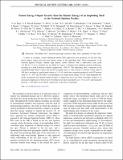Fusion Energy Output Greater than the Kinetic Energy of an Imploding Shell at the National Ignition Facility
Author(s)
Le Pape, S.; Berzak Hopkins, L. F.; Divol, L.; Pak, A.; Dewald, E. L.; Bhandarkar, S.; Bennedetti, L. R.; Bunn, T.; Biener, J.; Crippen, J.; Casey, D.; Edgell, D.; Fittinghoff, D. N.; Goyon, C.; Haan, S.; Hatarik, R.; Havre, M.; Ho, D. D-M.; Izumi, N.; Jaquez, J.; Khan, S. F.; Kyrala, G. A.; Ma, T.; Mackinnon, A. J.; MacPhee, A. G.; MacGowan, B. J.; Meezan, N. B.; Milovich, J.; Millot, M.; Michel, P.; Nagel, S. R.; Nikroo, A.; Patel, P.; Ralph, J.; Ross, J. S.; Rice, N. G.; Strozzi, D.; Stadermann, M.; Volegov, P.; Yeamans, C.; Weber, C.; Wild, C.; Callahan, D.; Hurricane, O. A.; Gatu Johnson, Maria; ... Show more Show less
DownloadPhysRevLett.120.245003.pdf (693.8Kb)
PUBLISHER_POLICY
Publisher Policy
Article is made available in accordance with the publisher's policy and may be subject to US copyright law. Please refer to the publisher's site for terms of use.
Terms of use
Metadata
Show full item recordAbstract
A series of cryogenic, layered deuterium-tritium (DT) implosions have produced, for the first time, fusion energy output twice the peak kinetic energy of the imploding shell. These experiments at the National Ignition Facility utilized high density carbon ablators with a three-shock laser pulse (1.5 MJ in 7.5 ns) to irradiate low gas-filled (0.3 mg/cc of helium) bare depleted uranium hohlraums, resulting in a peak hohlraum radiative temperature ∼290 eV. The imploding shell, composed of the nonablated high density carbon and the DT cryogenic layer, is, thus, driven to velocity on the order of 380 km/s resulting in a peak kinetic energy of ∼21 kJ, which once stagnated produced a total DT neutron yield of 1.9×10¹⁶ (shot N170827) corresponding to an output fusion energy of 54 kJ. Time dependent low mode asymmetries that limited further progress of implosions have now been controlled, leading to an increased compression of the hot spot. It resulted in hot spot areal density (ρr∼0.3 g/cm²) and stagnation pressure (∼360 Gbar) never before achieved in a laboratory experiment.
Date issued
2018-06Department
Massachusetts Institute of Technology. Plasma Science and Fusion CenterJournal
Physical Review Letters
Publisher
American Physical Society
Citation
Le Pape, S. et al. "Fusion Energy Output Greater than the Kinetic Energy of an Imploding Shell at the National Ignition Facility." Physical Review Letters 120, 24 (June 2018): 245003 © 2018 American Physical Society
Version: Final published version
ISSN
0031-9007
1079-7114